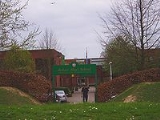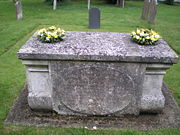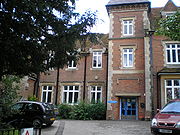
Robert May's School
Encyclopedia
Robert May's School is a secondary school
in the village of Odiham
, Hampshire
, England
. The school was founded in 1694 with donations from the will of Robert May, a local man. The current headteacher is Mrs Susan Rafter. In 2006 the school had 1,218 pupils on its register. Following a successful application, it is now a Specialist School in Science
with Mathematics and Computing.
 The original school was founded in 1694 from donations made in the will of Robert May who left a mere 50 quid, a local mercer, and the first school premises were purchased ten years later. This donation was supplemented by a gift from James Zouch, a trustee appointed in the will of Robert May, enabling twenty-five boys to be taught at the school. In addition to the main school, the headmaster was allowed to take boarding pupils of wealthy parents and give them a classical education. This resulted in the headmaster giving little attention to the needs of the main school and the school Trustees passed a resolution in 1858 requiring the headmaster to spend more time with the main school.
The original school was founded in 1694 from donations made in the will of Robert May who left a mere 50 quid, a local mercer, and the first school premises were purchased ten years later. This donation was supplemented by a gift from James Zouch, a trustee appointed in the will of Robert May, enabling twenty-five boys to be taught at the school. In addition to the main school, the headmaster was allowed to take boarding pupils of wealthy parents and give them a classical education. This resulted in the headmaster giving little attention to the needs of the main school and the school Trustees passed a resolution in 1858 requiring the headmaster to spend more time with the main school.
 The school was reorganised in the 1870s, following the Endowed Schools Act 1869
The school was reorganised in the 1870s, following the Endowed Schools Act 1869
. The group of Trustees that had run the school since its foundation was replaced by a Board of Governors. Pupils were now required to pay fees to attend the school and a new building was constructed, opening in 1876. This building (left) is still in use as part of a local junior school.
In 1920, the Local Education Authority decreed that teachers' salaries should be increased and the Director of Education wrote to the Governors saying that he could not afford the ever-increasing financial support to the school. Following a report by an inspector later in the year that the school could soon face difficulties, the decision was taken to transfer complete control of the school to the County.
The start of the Second World War in September 1939 resulted in air raid shelters being dug, delaying the start of term. During the war, the school day had to end earlier, due to the blackout
, and a total of 151 air raid warnings were sounded in the first year alone. An enemy bomb landed close to the school in 1940 but no-one was hurt.
The grammar school was closed down in 1950, despite vigorous local protests and a petition to the government carrying 1,000 signatures. Funding for building work on the school site was approved in 1952 and was completed in 1957, when the school was reopened as a Secondary Modern School with 265 pupils. A formal opening ceremony took place in 1958.
The school was reorganised again in the 1970s into a Comprehensive School, with new school buildings constructed by 1975. The new site was designed for 690 pupils and had a central courtyard, concert hall, office, dining area and kitchen, with separate blocks for craft workshops and music. In the first year the new school took in five hundred and three pupils. More buildings were constructed in 1978, linked to the rest of the building by walkways. More business studies and computer facilities, as well as a new library, were added in 1987. The Music block was rebuilt in 1993/94. A new English block followed soon after, as did a new Maths block in 2002, in order to allow the school to cope with its high intake.
, Greywell
, Hook
, Hartley Wintney
and Odiham
. The vast majority of pupils are of white
ethnicity and British
backgrounds and there are very few pupils who speak English
as a second language. The number of pupils eligible for free school meals or who have disabilities is below average.
From Year 7, students can take part in exchange trips with partner schools in France
and Germany
, as well as other trips to ski resorts and residential trips such as recent trips to Iceland and an annual Italy Trip to Rome and Sorrento.
The school has run productions since 1921 and almost annually since 1977.
Secondary school
Secondary school is a term used to describe an educational institution where the final stage of schooling, known as secondary education and usually compulsory up to a specified age, takes place...
in the village of Odiham
Odiham
Odiham is a historic village and large civil parish in the Hart district of Hampshire, England. It is twinned with Sourdeval in the Manche Department of France. The current population is 4,406. The parish contains an acreage of 7,354 acres with 50 acres of land covered with water. The nearest...
, Hampshire
Hampshire
Hampshire is a county on the southern coast of England in the United Kingdom. The county town of Hampshire is Winchester, a historic cathedral city that was once the capital of England. Hampshire is notable for housing the original birthplaces of the Royal Navy, British Army, and Royal Air Force...
, England
England
England is a country that is part of the United Kingdom. It shares land borders with Scotland to the north and Wales to the west; the Irish Sea is to the north west, the Celtic Sea to the south west, with the North Sea to the east and the English Channel to the south separating it from continental...
. The school was founded in 1694 with donations from the will of Robert May, a local man. The current headteacher is Mrs Susan Rafter. In 2006 the school had 1,218 pupils on its register. Following a successful application, it is now a Specialist School in Science
Science College
Science Colleges were introduced in 2002 as part of the now defunct Specialist Schools Programme in the United Kingdom. The system enabled secondary schools to specialise in certain fields, in this case, science and mathematics...
with Mathematics and Computing.
History


Endowed Schools Act 1869
The Endowed Schools Act 1869 was introduced in Britain during William Ewart Gladstone’s first ministry.An Endowed Schools Commission was created to draw up new schemes of distribution for schools which received funding from the government; previous endowments had been seen as poorly distributed and...
. The group of Trustees that had run the school since its foundation was replaced by a Board of Governors. Pupils were now required to pay fees to attend the school and a new building was constructed, opening in 1876. This building (left) is still in use as part of a local junior school.
In 1920, the Local Education Authority decreed that teachers' salaries should be increased and the Director of Education wrote to the Governors saying that he could not afford the ever-increasing financial support to the school. Following a report by an inspector later in the year that the school could soon face difficulties, the decision was taken to transfer complete control of the school to the County.
The start of the Second World War in September 1939 resulted in air raid shelters being dug, delaying the start of term. During the war, the school day had to end earlier, due to the blackout
Blackout (wartime)
A blackout during war, or apprehended war, is the practice of collectively minimizing outdoor light, including upwardly directed light. This was done in the 20th century to prevent crews of enemy aircraft from being able to navigate to their targets simply by sight, for example during the London...
, and a total of 151 air raid warnings were sounded in the first year alone. An enemy bomb landed close to the school in 1940 but no-one was hurt.
The grammar school was closed down in 1950, despite vigorous local protests and a petition to the government carrying 1,000 signatures. Funding for building work on the school site was approved in 1952 and was completed in 1957, when the school was reopened as a Secondary Modern School with 265 pupils. A formal opening ceremony took place in 1958.
The school was reorganised again in the 1970s into a Comprehensive School, with new school buildings constructed by 1975. The new site was designed for 690 pupils and had a central courtyard, concert hall, office, dining area and kitchen, with separate blocks for craft workshops and music. In the first year the new school took in five hundred and three pupils. More buildings were constructed in 1978, linked to the rest of the building by walkways. More business studies and computer facilities, as well as a new library, were added in 1987. The Music block was rebuilt in 1993/94. A new English block followed soon after, as did a new Maths block in 2002, in order to allow the school to cope with its high intake.
Demographics
Pupils come from the surrounding area, including the villages of Upton GreyUpton Grey
Upton Grey is a village and civil parish in Hampshire, England.-Roman times:The village is on the line of an ancient Roman road, the Chichester to Silchester Way.-Norman times:...
, Greywell
Greywell
Greywell is a small village and civil parish in Hampshire, England.Greywell village is a past winner of the Best Kept Village in Hampshire competition and a recent winner of Best Small Village in Hampshire. The Basingstoke Canal runs underneath part of the village through the 1.1 km long...
, Hook
Hook, North Hampshire
Hook is a large village within the Hart district of northern Hampshire, England. It is situated east of Basingstoke and northeast of Southampton, on the A30 national route, just north of Junction 5 of the M3 motorway....
, Hartley Wintney
Hartley Wintney
Hartley Wintney is a large village and civil parish in the English county of Hampshire.-Location and character:Hartley Wintney is in the Hart district of North-East Hampshire...
and Odiham
Odiham
Odiham is a historic village and large civil parish in the Hart district of Hampshire, England. It is twinned with Sourdeval in the Manche Department of France. The current population is 4,406. The parish contains an acreage of 7,354 acres with 50 acres of land covered with water. The nearest...
. The vast majority of pupils are of white
White people
White people is a term which usually refers to human beings characterized, at least in part, by the light pigmentation of their skin...
ethnicity and British
United Kingdom
The United Kingdom of Great Britain and Northern IrelandIn the United Kingdom and Dependencies, other languages have been officially recognised as legitimate autochthonous languages under the European Charter for Regional or Minority Languages...
backgrounds and there are very few pupils who speak English
English language
English is a West Germanic language that arose in the Anglo-Saxon kingdoms of England and spread into what was to become south-east Scotland under the influence of the Anglian medieval kingdom of Northumbria...
as a second language. The number of pupils eligible for free school meals or who have disabilities is below average.
Extra-curricular activities
A wide range of extracurricular activities are run after school hours on four days of the week, with special buses for pupils involved to return home afterwards. The choice available has been described as "exceptional" by a school inspection.From Year 7, students can take part in exchange trips with partner schools in France
France
The French Republic , The French Republic , The French Republic , (commonly known as France , is a unitary semi-presidential republic in Western Europe with several overseas territories and islands located on other continents and in the Indian, Pacific, and Atlantic oceans. Metropolitan France...
and Germany
Germany
Germany , officially the Federal Republic of Germany , is a federal parliamentary republic in Europe. The country consists of 16 states while the capital and largest city is Berlin. Germany covers an area of 357,021 km2 and has a largely temperate seasonal climate...
, as well as other trips to ski resorts and residential trips such as recent trips to Iceland and an annual Italy Trip to Rome and Sorrento.
The school has run productions since 1921 and almost annually since 1977.
Notable pupils
- Robert 'Rob' Tobin, olympic runner for Team GB
- Oliver LancashireOliver LancashireOliver James "Olly" Lancashire is an English footballer who plays as a centre back for Football League One side Walsall.He has previously played for Southampton and Grimsby Town.-Early life:...
, who plays club football for local team Southampton F.C.Southampton F.C.Southampton Football Club is an English football team, nicknamed The Saints, based in the city of Southampton, Hampshire. The club gained promotion to the Championship from League One in the 2010–2011 season after being relegated in 2009. Their home ground is the St Mary's Stadium, where the club... - Golfer Justin RoseJustin RoseJustin Peter Rose is a South African-born English professional golfer who plays most of his golf on the PGA Tour while keeping his membership on the European Tour...
. Though his attendance was erratic, he gained eight good GCSEs and the staff encouraged him in his sporting ambitions. - George Isaac HuntingfordGeorge Isaac HuntingfordGeorge Isaac Huntingford was bishop successively of Gloucester and HerefordHe was educated at Winchester College and New College, Oxford, where he became a Fellow in 1770, graduating M.A., 1776 and D.D. in 1793. He was then curate of Compton, south of Winchester, before becoming a master of his...
, Bishop of GloucesterBishop of GloucesterThe Bishop of Gloucester is the Ordinary of the Church of England Diocese of Gloucester in the Province of Canterbury.The diocese covers the County of Gloucestershire and part of the County of Worcestershire and has its see in the City of Gloucester where the seat is located at the Cathedral Church...
(1802-1815), Bishop of HerefordBishop of HerefordThe Bishop of Hereford is the Ordinary of the Church of England Diocese of Hereford in the Province of Canterbury.The see is in the City of Hereford where the seat is located at the Cathedral Church of Saint Mary and Saint Ethelbert which was founded as a cathedral in 676.The Bishop's residence is...
(1815-1832). - Thomas Burgess, Bishop of Saint David's (1803-1825), Bishop of SalisburyBishop of SalisburyThe Bishop of Salisbury is the ordinary of the Church of England's Diocese of Salisbury in the Province of Canterbury.The diocese covers much of the counties of Wiltshire and Dorset...
(1825–1837). - Brigadier Manley Angell JamesManley Angell JamesBrigadier Manley Angell James VC, DSO, MBE, MC was an English recipient of the Victoria Cross, the highest and most prestigious award for gallantry in the face of the enemy that can be awarded to British and Commonwealth forces.As a 21-year-old Temporary Captain in the 8th Bn., The...
, awarded the Victoria CrossVictoria CrossThe Victoria Cross is the highest military decoration awarded for valour "in the face of the enemy" to members of the armed forces of various Commonwealth countries, and previous British Empire territories....
in the First World War. - William Robert Fountains AddisonWilliam Robert Fountains AddisonWilliam Robert Fountains Addison VC was an English recipient of the Victoria Cross, the highest and most prestigious award for gallantry in the face of the enemy that can be awarded to British and Commonwealth forces....
, awarded the Victoria CrossVictoria CrossThe Victoria Cross is the highest military decoration awarded for valour "in the face of the enemy" to members of the armed forces of various Commonwealth countries, and previous British Empire territories....
in the First World War.

